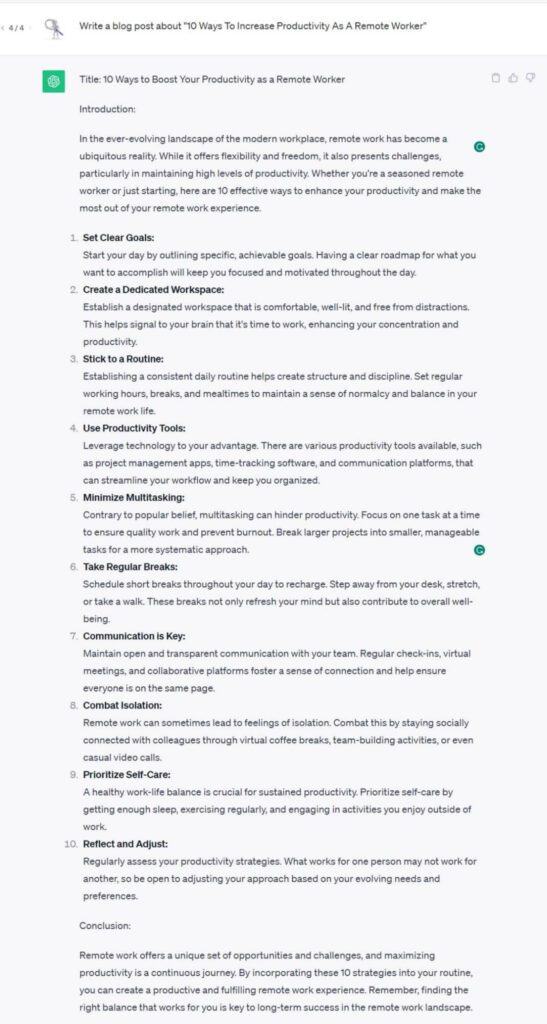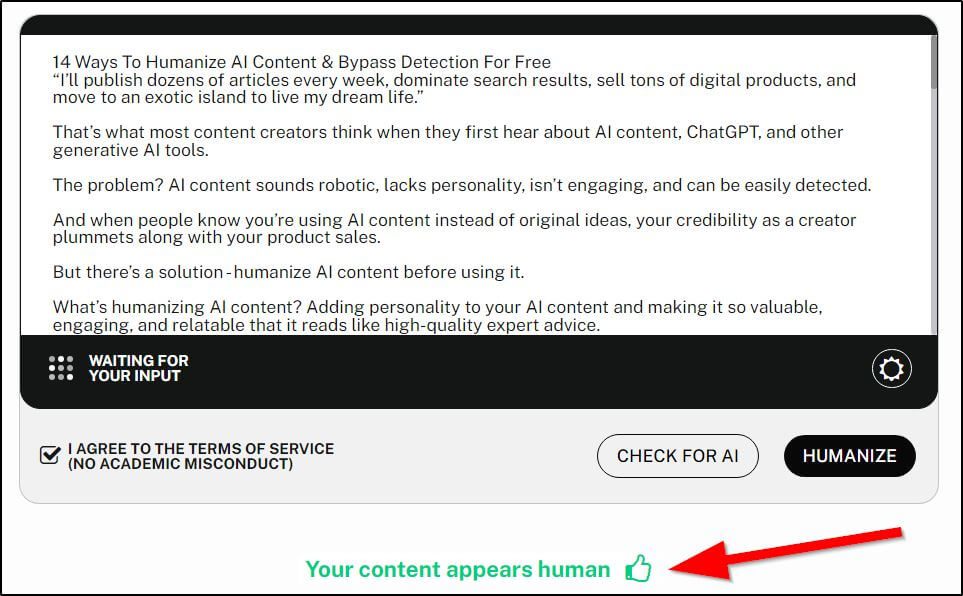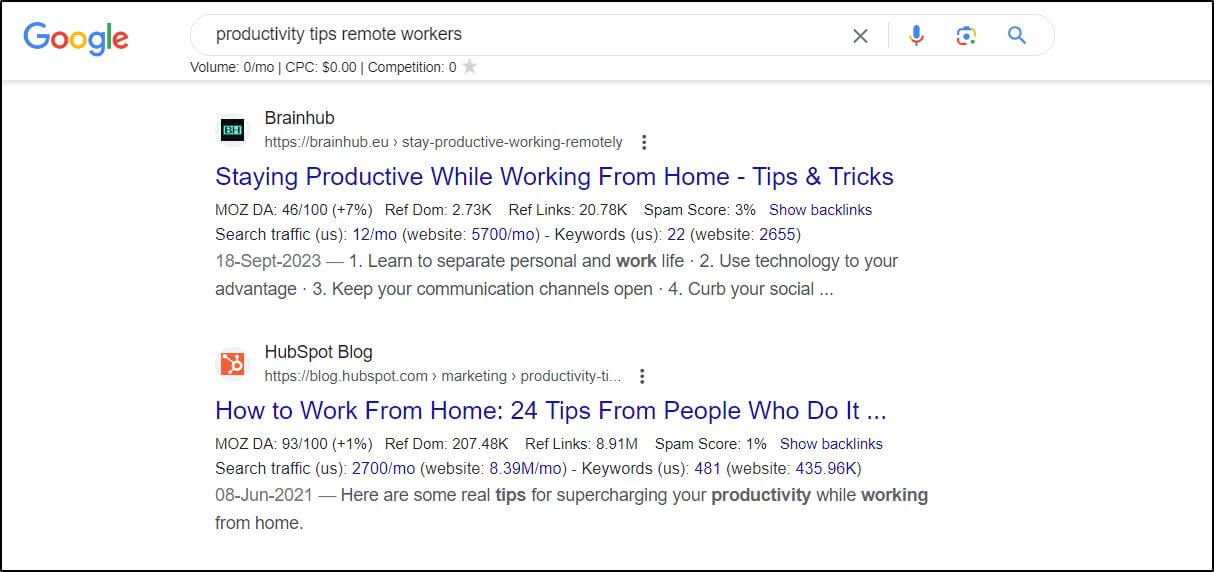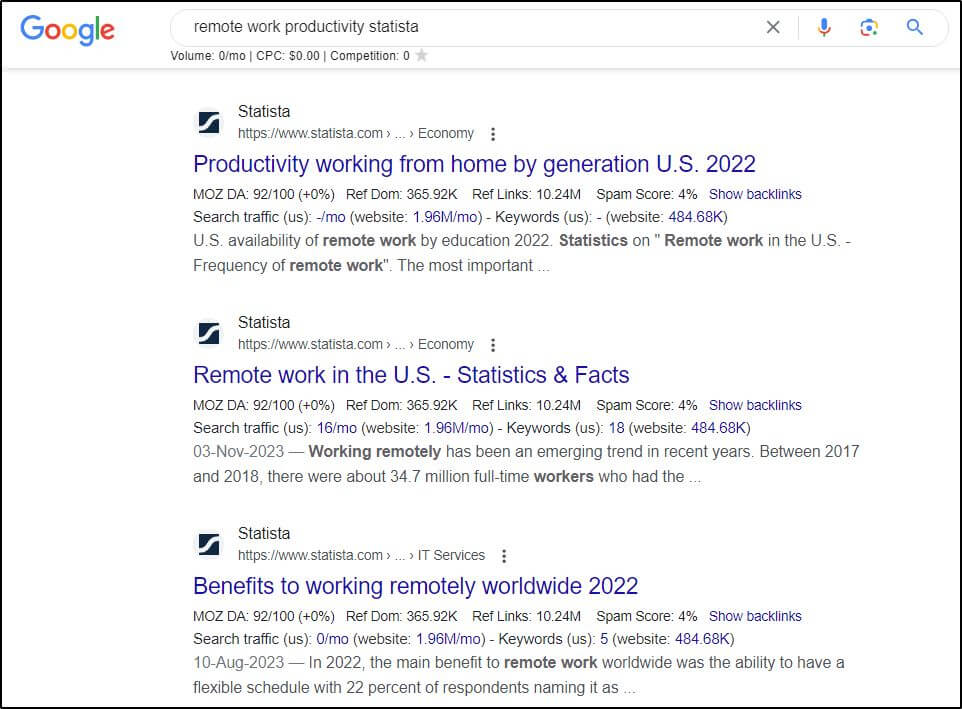

Imagine this: publishing unlimited content, dominating search results, selling tons of digital products, and eventually having the means to live your dream life.
For content creators, that could actually be attainable now, given the possibilities that exist with AI content, ChatGPT, and other generative AI tools.
But here’s the catch – AI-generated content often falls flat, lacking personality and engaging the audience.
When your audience detects robotic, impersonal content, your credibility takes a nosedive, and so do your product sales.
The solution? Humanizing AI content.
What does that mean? It’s about infusing your AI-generated text with personality, value, and relatability. We’re not talking about a one-click solution magically producing publish-ready AI articles (those tools don’t exist yet.)
Instead, we’ll discuss ways to transform an AI text draft into compelling human-like content.
Interested? Let’s dive in and explore powerful ways to humanize AI content, bypass detection, and elevate your content creation game.
AI Text vs. Humanized Content – What’s The Difference?
Both AI text and humanized content are created using generative AI tools.
But the similarities end there.
AI content is vague, has no distinct voice or emotions, and lacks the human touch. Its sentences have a set pattern, and its stats and examples are often factually incorrect.
AI detection tools, and even regular readers, can identify such content easily.
Humanized content is the improved version of an AI text draft. It is generated with the same AI tools, but it’s edited and tailored to a specific audience, has a personality and voice, provides value to the readers, and uses accurate data and examples.
In short, humanized content is a drastically improved version of plain AI content that is genuinely helpful to the readers and cannot be detected easily.
Why Is It Important To Humanize AI Content?
The success of your creator business depends entirely on your credibility and relationship with your audience.
People don’t buy courses just for information. They can learn whatever they want from Google or YouTube.
They buy courses because of your personality and unique story and because they want you to guide them.
Generative AI technology uses information already there on the internet, learns from it, and uses it to create similar content.
It might be unique in its words, but it doesn’t offer anything new.
If you take yourself out of your content and give readers a robotic text that shares everything they want to know but lacks your story, experiences, and personal touch, they won’t buy from you ever again.
It kills the purpose of building a creator brand, which is to offer unique value based on personal experiences.
Even from an SEO perspective, you’ll only outrank your competitors when your content is superior, not an average version of everything already published.
But we understand your challenge.
You want to speed up content creation and simplify your business with AI content.
This is where humanizing AI content comes in.
You’ll use ChatGPT and other generative AI text tools to create content faster than human writers. But improve it by adding personal experiences, a unique voice, and more value for the readers.
Exactly how will you do it? Let’s find out.
How To Humanize AI Written Content And Make It Undetectable
Let’s start by generating an AI-written article with ChatGPT. As you’ll see, it’ll be a bland piece of text that’ll make your readers yawn. Plus, even free AI detectors will easily catch it.


Now, we’ll run it through a free AI detector by CopyLeaks.


Let’s confirm using another free AI content detector.


We simply copied this article from ChatGPT, and even free AI detectors immediately raised the red flag.
To show you that these tools can tell the difference between human-written and AI content, we ran our article through it as well.


We wrote this one ourselves.
But let’s discuss ways we can humanize AI content to a level where even premium AI detectors can’t catch it.
1. Write Detailed AI Prompts
If your ChatGPT prompts are anything like the one we used to generate the article on productivity tips, you’ll always get robotic AI content.
Why? Because ChatGPT is pretty bad at generating complex long-form content in one go.
But if you break down the writing process, use detailed prompts, describe your tone and style, and give ChatGPT more context, it can write much superior content.
Here’s how you can do it.
Step 1: Start A New Chat Thread
ChatGPT treats every thread as a separate conversion. You can use threads to train ChatGPT on a specific topic and provide context to your prompts.
So, start a fresh thread for every new piece of content so that ChatGPT can easily understand your prompts.
Step 2: Generate An Outline
We’ll take the same topic, “Ways To Increase Productivity As A Remote Worker”. But instead of asking ChatGPT to write the whole article, we’ll use it to generate an outline.
We’re generating this outline for a blog post. But you can use the same process for creating course lessons, video scripts, or any other content type.
Let’s start with a simple prompt to get an outline.


If you look at our prompt, we’ve asked ChatGPT to add pointers to the outline explaining how to cover each section.
This will come in handy later in our writing process.
We now have the core sections of the article and their primary discussion points. Quickly go over it and add/remove any areas to make this outline more specific to your topic.
Step 2: Find The Best Content On Your Topic
Now comes the fun part.
If you want your content to be different, unique, valuable, and read like it’s written by a human, you must train ChatGPT to do it.
How? Feed it with the most relevant and high-quality content to use as a reference while creating your article.
For this, we’ll use an AI-powered search engine called Perplexity, which hand-picks content from different online sources based on your preferences.


We asked Perplexity to focus on Reddit threads and find us the biggest productivity challenges of remote workers.
Why Reddit? Because it has the most natural and raw feedback from real users, which can make our content truly unique.


Within seconds, you have the crux of the most popular Reddit discussion on your topic.
Now open another tab and search your topic on Google.


Handpick the best articles from the top search results and open them in separate tabs. We recommend shortlisting at least five pieces significantly different from each other.
Now, return to your ChatGPT thread.
Step 3: Copy/Paste Into ChatGPT
It’s time to feed ChatGPT with your research data for creating your article.
We’ll start by telling it what we plan to do.


See, your AI assistant is ready.
Now copy/paste all the information you’ve researched into ChatGPT one by one using the following prompt.


We gave it the answers from Perplexity first.
Then, we added all the articles we found during our research to the ChatGPT thread.


If you want to make your content more unique, copy/paste information from Quora threads, social media discussion forums, or detailed articles about your topic in your ChatGPT thread.
Once you have enough data, move to the next step.
Step 4: Generate Every Section Separately
Instead of writing the whole article, ask ChatGPT to use the information you’ve shared to write each section separately.
Let’s start with the introduction.


Thanks to all the content we’ve given ChatGPT, this introduction is better than a default AI article intro.
However, it’s still useless because it contains complex words and unclear sentences. We need to simplify it to turn it into an engaging blog post.
But first, let’s generate the whole article (one section at a time) using the same outline ChatGPT gave us.
Remind ChatGPT about the article outline at every step.


This is important because ChatGPT can easily mix up messages and start creating content from scratch without you even noticing.


Generate every section the same way.


After generating content for every section in the outline, copy and organize it in a separate Google Docs file.
Step 5: Fine Tune Your Content Voice And Style
We have a 1300-word article that would’ve easily made it to any blog or publication in the pre-ChatGPT era.
Right now, it can be easily detected because AI is written all over it.
So, we must change its voice and make it easier to read.
Thankfully, ChatGPT can do it in just a few prompts.


If you read the introduction paragraph now, it sounds more like a blog post. It’s more conversational, has better flow, and doesn’t use any jargon.
Simplify every section the same way until you’re happy with the draft.
Will this article pass AI detection? Not yet.
Is it good enough to publish on your blog or use as a lesson in your course? Not yet.
But it’s much more engaging and human-like than the first draft and makes a great starting point for further improvements that we’ll make in this article.
2. Explain With Real-World Examples
One of the best ways to humanize your AI content is by adding real-world examples and case studies to back your arguments.
It not only makes your content more persuasive and easier to understand but also adds an original flavor because AI content doesn’t include fresh examples.
So, let’s find a few examples for our productivity article.


A simple Google search gives us 6-7 case studies from universities and academic institutions like Harvard University, Walton, and others.
We can link them under different subheadings in our article to make stronger arguments.
Perplexity makes finding examples even easier.


We chose “Academic” as our search focus, and Perplexity instantly gave us 5-6 sax studies showing a positive relationship between productivity and remote work.
Citing these credible sources in different sections of our post will make it super valuable for the readers, unlike generic AI content.
3. Use Everyday Language In A Conversational Tone
While generating AI content, we simplified it by adding “Hemingway score 8” in our prompt. But you still need to manually review your post and ensure it uses everyday language only.
Why? Because AI loves to throw around jargon and use complex words that people normally don’t use in their day-to-day conversations.
To humanize your content, you must:
- Shorten your sentences.
- Use a conversational tone that speaks directly to the reader.
- Have short paragraphs of 1-2 lines max.
- Don’t use jargon unless there’s no choice.
- Add humor to your content.
- Use bucket brigades to enhance your content engagement rate.
In short, simplify your copy.
AI tools can only do that to a certain extent. So, you’ll have to do it yourself or hire an expert editor to tailor the content voice to your audience.
4. Mention Your Older Content
Whether you’re creating an online course lesson or an article for your blog, recalling your older content is a subtle way to humanize your content and make it more engaging.
Because AI cannot access your content archives and doesn’t know what you’ve previously discussed.
For example, when discussing a strategy in your article, say, “If you recall the case study I shared with you in the previous lesson, we intentionally stacked all the links to build our page authority.”
By doing so and linking to your archive content, you not only make your content more comprehensive and useful for your readers but also make it harder to detect.
5. Add Personal Experiences
Perhaps the best way to humanize your content and make it high authority is by discussing your personal experiences and experiments.
If you have original case studies or test results from a past experiment, use them to back your arguments and share your learnings with your audience.
This adds your unique personality to the content, positions you as an expert, and makes your content different.
AI content cannot do that because it doesn’t have personal experiences.
That’s probably why last year, after ChatGPT’s original launch, Google added another “E” (for Experience) to its E-A-T (Expertise, Authoritativeness, Trustworthiness) guidelines.


This simply means that to rank for a competitive keyword in search results, the content should be backed by the author’s personal experiences, expertise, authority, and trust.
This is a good indicator of how personal experiences humanize content and make it more trustworthy.
So, once you generate an AI article using the prompts we’ve discussed, read it carefully to find any areas where you can add personal experiences to make the content more authentic.
6. Include Fresh Data And Research
One of our favorite ways to humanize AI content and make it more credible is by using fresh data and research findings to back our claims.
One of AI content’s biggest flaws is that it generates hypothetical studies and fake stats.
So, do this manually instead of relying on ChatGPT or any other AI content generator for stats.
For example, if we want to humanize our remote productivity article, we can get original data from sites like Statista or Pew Research.


If you don’t find relevant stats, search for your keyword and stats on Google to get curated stats from different blogs. But don’t forget to trace the original source before using any data in your content.
Ideally, find a stat or research for every section in your article so that no claim in your content is without proof.
7. Quote Real-World Experts
By now, your content is already superior to any raw AI-generated text. But if you want to take it to the next level and surpass even the best human-written content on your topic, include unique thoughts and quotes by real-world experts.
We’re not talking about generic quotes that anyone can create. An expert quote should be unique based on an authority figure’s experiences.
It instantly adds credibility and originality to your content that no AI can replicate.
Shopify publishes some of the best eCommerce content on the web. And original expert quotes are a mandatory part of all their articles.


Where to find expert quotes?
Twitter is our favorite place because it gives you easy access to the brightest minds in your industry and makes it easy to exchange ideas and get unique quotes from experts.
But other platforms like Help A Reporter Out (HARO) and Help A B2B Writer can also help you connect with subject matter experts willing to share quotes and insights for a backlink.
How many quotes should you include in an article?
Quoting 1-2 experts on a topic is enough to make your content 10x better than plain opinionated pieces.
8. Embed Useful Visuals
If you want your blog content to be more engaging, helpful, and humanized, include original annotated screenshots and relevant videos.
We’re not talking about stock images or generic Ai generated images that add no value to the content.
Instead, get screenshots that complement your content and make it easier to understand for your readers.
For example, here’s a screenshot from an article on ConvertKit Blog describing the elements of a good landing page along with a screenshot.


Similarly, embed short original videos to instantly make your content more valuable than your competitors.
Ahrefs, one of the best content marketing practitioners, often includes relevant videos in its blog posts.


And finally, if you want to go the extra mile, use a tool like Canva or Visme to create an infographic explaining the core points in your content.
Adding these visuals not only makes your content more original and humanized but also helps you get backlinks to improve your search rankings.
9. Optimize Your Content For Search Engines (SEO)
If you publish a copy/paste AI article on your site, it won’t rank for search results. And even if it does, its rankings will tank in a few weeks when Google’s algorithms catch up with it.
“But Google said it has no issues with AI content anymore.”, is that what you’re saying?
Yes, Google has categorically said that it will index and rank AI content, but only as long as it is written for humans and offers real value.
But raw AI content is simply an average version of the content that already exists online. It offers nothing new or unique for Google to rank.
That’s why we’ve improved our AI draft by adding examples, personal experiences, and an engaging voice.
The only thing left is to optimize it for SEO.
But optimization isn’t about keywords only.
Here’s what you need to do to make your AI content ready to attract search traffic (and appear human-like in the process).
- Understand the search intent of your target keyword and ensure your content is aligned with it.
- Answer the user’s primary query in the first half of your page.
- Use your target keyword in the title, description, and URL of the page.
- Use your target keyword naturally throughout the content and in at least one H2 and H3 subheading.
- Fetch the questions related to your keyword from the “People Also Ask” section in Google Search and answer them in your content.
- Use your keyword in your image alt-text.
Read our detailed SEO guide to help you create content that drives organic traffic to your site.
But why did we include SEO in this article? Because, at its core, SEO is about humanizing your content. Google wants you to create content that meets your audience’s search intent, answers their questions, and retains their interest longer than your competitors.
You can’t retain your audience’s attention without creating high-quality content in an engaging tone. Even when generating AI content, it’s crucial to enhance it significantly using the techniques we’ve shared to stand a chance in search rankings.
Is It Enough To Avoid AI Content Detection?
If you follow the steps discussed in this article, your content will bypass most AI content detection tools.
But is that enough? Not really.
The bigger question is whether your humanized content can help you achieve your goals.
If it’s a sales page, does it drive conversions?
If it’s a blog post, does it strengthen your brand and rank in search?
If it’s an online course lesson, does it help your students learn anything new?
Sometimes, even humanized AI content won’t do the job without expert review.
So, after generating undetectable AI content, make sure an editor, writer, and conversion specialist takes a good look at it so that it helps you achieve your goals.
Table of Contents



